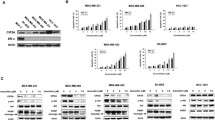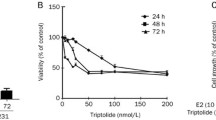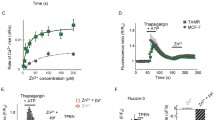Abstract
Treatment with tamoxifen, or its metabolite 4-hydroxytamoxifen (4OHT), has cytostatic and cytotoxic effects on breast cancer cells in vivo and in culture. Although the effectiveness of 4OHT as an anti-breast cancer agent is due to its action as an estrogen receptor-alpha (ERα) antagonist, evidences show that 4OHT is also cytotoxic for ERα-negative breast cancer cells and can be effective therapy against tumors that lack estrogen receptors. These findings underscore 4OHT signaling complexities and belie the most basic understandings of 4OHT action and resistance. Here, we have investigated the effects of 4OHT on Ca2+ homeostasis and cell death in breast cancer cells in culture. Measurement of Ca2+ signaling in breast cancer cells showed that 4OHT treatment altered Ca2+ homeostasis and was cytotoxic for both an ERα+ and an ERα- cell line, MCF-7 and MDA-MB-231, respectively. Further investigation lead us to the novel discovery that 4OHT-induced increase of ATP-dependent Ca2+ release from the endoplasmic reticulum correlated with 4OHT-induced upregulation of protein phosphatase 1α (PP1α) and the inositol 1,4,5-trisphosphate receptor (IP3R). Blocking 4OHT-induced PP1α upregulation by siRNA strategy reduced the effects of 4OHT on both Ca2+ signaling and cytotoxicity. Results from these investigations strongly suggest a role for PP1α upregulation in a mechanism for 4OHT-induced changes to Ca2+ signaling that ultimately contribute to the cytotoxic effects of 4OHT.






Similar content being viewed by others
Abbreviations
- PP1α:
-
Protein Phosphatase 1 alpha
- Ca2+ :
-
Calcium
- EnR:
-
Endoplasmic reticulum
- ER:
-
Estrogen receptor
- IP3R:
-
Inositol 1,4,5-trisphosphate (IP3) receptor
- 4OHT:
-
4-Hydroxytamoxifen
- SOCE:
-
Store-operated calcium entry
- Tg:
-
Thapsigargin
References
Osborne CK, Zhao H, Fuqua SA (2000) Selective estrogen receptor modulators: structure, function, and clinical use. J Clin Oncol 18(17):3172–3186
Watts CK, Sweeney KJ, Warlters A, Musgrove EA, Sutherland RL (1994) Antiestrogen regulation of cell cycle progression and cyclin D1 gene expression in MCF-7 human breast cancer cells. Breast Cancer Res Treat 31(1):95–105
Tchou J, Hou N, Rademaker A, Jordan VC, Morrow M (2004) Acceptance of tamoxifen chemoprevention by physicians and women at risk. Cancer 100(9):1800–1806
Vogel VG, Costantino JP, Wickerham DL, Cronin WM, Cecchini RS, Atkins JN, Bevers TB, Fehrenbacher L, Pajon ER Jr, Wade JL 3rd et al (2006) Effects of tamoxifen vs raloxifene on the risk of developing invasive breast cancer and other disease outcomes: the NSABP Study of tamoxifen and Raloxifene (STAR) P-2 trial. JAMA 295(23):2727–2741
Lonning PE, Hall K, Aakvaag A, Lien EA (1992) Influence of tamoxifen on plasma levels of insulin-like growth factor I and insulin-like growth factor binding protein I in breast cancer patients. Cancer Res 52(17):4719–4723
Lee JE, Chung KW, Han W, Kim SW, Shin HJ, Bae JY, Noh DY (2004) Effect of estrogen, tamoxifen and epidermal growth factor on the transcriptional regulation of vascular endothelial growth factor in breast cancer cells. Anticancer Res 24(6):3961–3964
Helguero LA, Faulds MH, Gustafsson JA, Haldosen LA (2005) Estrogen receptors alfa (ERalpha) and beta (ERbeta) differentially regulate proliferation and apoptosis of the normal murine mammary epithelial cell line HC11. Oncogene 24(44):6605–6616
Borgna JL, Rochefort H (1980) High-affinity binding to the estrogen receptor of [3H]4-hydroxytamoxifen, an active antiestrogen metabolite. Mol Cell Endo 20:71–85
Somai S, Chaouat M, Jacob D, Perrot JY, Rostene W, Forgez P, Gompel A (2003) Antiestrogens are pro-apoptotic in normal human breast epithelial cells. Int J Cancer 105(5):607–612
Jordan VC, Lewis JS, Osipo C, Cheng D (2005) The apoptotic action of estrogen following exhaustive antihormonal therapy: a new clinical treatment strategy. Breast 14(6):624–630
Furr BJ, Jordan VC (1984) The pharmacology and clinical uses of tamoxifen. Pharmacol Ther 25(2):127–205
Decensi A, Robertson C, Viale G et al (2003) A randomized trial of low-dose tamoxifen on breast cancer proliferation and blood estrogenic biomarkers. JNCI 95:779–790
Peyrade F, Frenay M, Etienne MC, Ruch F, Guillemare C, Francois E, Namer M, Ferrero JM, Milano G (1996) Age-related difference in tamoxifen disposition. Clin Pharmacol Ther 59(4):401–410
MacCallum J, Cummings J, Dixon JM, Miller WR (2000) Concentrations of tamoxifen and its major metabolites in hormone responsive and resistant breast tumours. Br J Cancer 82(10):1629–1635
Kallio A, Zheng A, Dahllund J, Heiskanen KM, Harkonen P (2005) Role of mitochondria in tamoxifen-induced rapid death of MCF-7 breast cancer cells. Apoptosis 10(6):1395–1410
Chiarenza A, Lazarovici P, Lempereur L, Cantarella G, Bianchi A, Bernardini R (2001) Tamoxifen inhibits nerve growth factor-induced proliferation of the human breast cancerous cell line MCF-7. Cancer Res 61(7):3002–3008
Jain PT, Trump BF (1997) Tamoxifen induces deregulation of [Ca2+] in human breast cancer cells. Anticancer Res 17(2A):1167–1174
Iwao K, Miyoshi Y, Egawa C, Ikeda N, Noguchi S (2000) Quantitative analysis of estrogen receptor-beta mRNA and its variants in human breast cancers. Int J Cancer 88(5):733–736
Mandlekar S, Hebbar V, Christov K, Kong AN (2000) Pharmacodynamics of tamoxifen and its 4-hydroxy and N-desmethyl metabolites: activation of caspases and induction of apoptosis in rat mammary tumors and in human breast cancer cell lines. Cancer Res 60(23):6601–6006
Mandlekar S, Yu R, Tan TH, Kong AN (2000) Activation of caspase-3 and c-Jun NH2-terminal kinase-1 signaling pathways in tamoxifen-induced apoptosis of human breast cancer cells. Cancer Res 60(21):5995–6000
Ellis PA, Saccani-Jotti G, Clarke R, Johnston SR, Anderson E, Howell A, A’Hern R, Salter J, Detre S, Nicholson R et al (1997) Induction of apoptosis by tamoxifen and ICI 182780 in primary breast cancer. Int J Cancer 72(4):608–613
Hui AM, Zhang W, Chen W, Xi D, Purow B, Friedman GC, Fine HA (2004) Agents with selective estrogen receptor (ER) modulator activity induce apoptosis in vitro and in vivo in ER-negative glioma cells. Cancer Res 64(24):9115–9123
Ward HW (1973) Anti-oestrogen therapy for breast cancer: a trial of tamoxifen at two dose levels. Br Med J 1(5844):13–14
Jordan VC, Dowse LJ (1976) Tamoxifen as an anti-tumour agent: effect on oestrogen binding. J Endocrinol 68(02):297–303
Campanella M, Pinton P, Rizzuto R (2004) Mitochondrial Ca2+ homeostasis in health and disease. Biol Res 37(4):653–660
Mandlekar S, Kong AN (2001) Mechanisms of tamoxifen-induced apoptosis. Apoptosis 6(6):469–477
Armstrong JS (2006) Mitochondria: a target for cancer therapy. Br J Pharmacol 147(3):239–248
Pinton P, Rizzuto R (2006) Bcl-2 and Ca2+ homeostasis in the endoplasmic reticulum. Cell Death Differ 13(8):1409–1418
Festjens N, Vanden Berghe T, Vandenabeele P (2006) Necrosis, a well-orchestrated form of cell demise: signalling cascades, important mediators and concomitant immune response. Biochim Biophys Acta 1757(9–10):1371–1387
Pinton P, Ferrari D, Magalhaes P, Schulze-Osthoff K, Di Virgilio F, Pozzan T, Rizzuto R (2000) Reduced loading of intracellular Ca(2+) stores and downregulation of capacitative Ca(2+) influx in Bcl-2-overexpressing cells. J Cell Biol 148(5):857–862
Xu L, Kong D, Zhu L, Zhu W, Andrews DW, Kuo TH (2006) Suppression of IP3-mediated calcium release and apoptosis by Bcl-2 involves the participation of protein phosphatase 1. Mol Cell Biochem 295(1–2):153–165
Prakriya M, Feske S, Gwack Y, Srikanth S, Rao A, Hogan PG (2006) Orai1 is an essential pore subunit of the CRAC channel. Nature 443(7108):230–233
Chen R, Valencia I, Zhong F, McColl KS, Roderick HL, Bootman MD, Berridge MJ, Conway SJ, Holmes AB, Mignery GA et al (2004) Bcl-2 functionally interacts with inositol 1,4,5-trisphosphate receptors to regulate calcium release from the ER in response to inositol 1,4,5-trisphosphate. J Cell Biol 166(2):193–203
DeSouza N, Reiken S, Ondrias K, Yang YM, Matkovich S, Marks AR (2002) Protein kinase A and two phosphatases are components of the inositol 1,4,5-trisphosphate receptor macromolecular signaling complex. J Biol Chem 277(42):39397–39400
Zhang W, Couldwell WT, Song H, Takano T, Lin JH, Nedergaard M (2000) Tamoxifen-induced enhancement of calcium signaling in glioma and MCF-7 breast cancer cells. Cancer Res 60(19):5395–5400
Zhu W, Cowie A, Wasfy GW, Penn LZ, Leber B, Andrews DW (1996) Bcl-2 mutants with restricted subcellular location reveal spatially distinct pathways for apoptosis in different cell types. Embo J 15(16):4130–4141
Tsien RY, Rink TJ, Poenie M (1985) Measurement of cytosolic free Ca2+ in individual small cells using fluorescence microscopy with dual excitation wavelengths Cell Calcium 6(1–2):145–157
Mosmann T (1983) Rapid colorimetric assay for cellular growth and survival: application to proliferation and cytotoxicity assays. J Immunol Methods 65(1–2):55–63
Zhang SL, Yu Y, Roos J, Kozak JA, Deerinck TJ, Ellisman MH, Stauderman KA, Cahalan MD (2005) STIM1 is a Ca2+ sensor that activates CRAC channels, migrates from the Ca2+ store to the plasma membrane. Nature 437(7060):902–905
Sedova M, Klishin A, Huser J, Blatter LA (2000) Capacitative Ca2+ entry is graded with degree of intracellular Ca2+ store depletion in bovine vascular endothelial cells. J Physiol 523(Pt 3):549–559
Dowsett M, Houghton J, Iden C, Salter J, Farndon J, A’Hern R, Sainsbury R, Baum M (2006) Benefit from adjuvant tamoxifen therapy in primary breast cancer patients according oestrogen receptor, progesterone receptor, EGF receptor and HER2 status. Ann Oncol 17(5):818–826
Tang P, Roldan G, Brasher PM, Fulton D, Roa W, Murtha A, Cairncross JG, Forsyth PA (2006) A phase II study of carboplatin and chronic high-dose tamoxifen in patients with recurrent malignant glioma. J Neurooncol 78(3):311–316
Osborne CK, Pippen J, Jones SE, Parker LM, Ellis M, Come S, Gertler SZ, May JT, Burton G, Dimery I et al (2002) Double-blind, randomized trial comparing the efficacy and tolerability of fulvestrant versus anastrozole in postmenopausal women with advanced breast cancer progressing on prior endocrine therapy: results of a North American trial. J Clin Oncol 20(16):3386–3395
Zagranichnaya TK, Wu X, Danos AM, Villereal ML (2005) Gene expression profiles in HEK-293 cells with low or high store-operated calcium entry: can regulatory as well as regulated genes be identified? Physiol Genomics 21(1):14–33
Tang TS, Tu H, Wang Z, Bezprozvanny I (2003) Modulation of type 1 inositol (1,4,5)-trisphosphate receptor function by protein kinase a and protein phosphatase 1alpha. J Neurosci 23(2):403–415
Dohadwala M, da Cruz e Silva EF, Hall FL, Williams RT, Carbonaro-Hall DA, Nairn AC, Greengard P, Berndt N (1994) Phosphorylation and inactivation of protein phosphatase 1 by cyclin-dependent kinases. Proc Natl Acad Sci USA 91(14):6408–6412
Zhang GJ, Kimijima I, Onda M, Kanno M, Sato H, Watanabe T, Tsuchiya A, Abe R, Takenoshita S (1999) Tamoxifen-induced apoptosis in breast cancer cells relates to down-regulation of bcl-2, but not bax and bcl-X(L), without alteration of p53 protein levels. Clin Cancer Res 5(10):2971–2977
Liu CW, Wang RH, Berndt N (2006) Protein phosphatase 1alpha activity prevents oncogenic transformation. Mol Carcinog 45(9):648–656
Garcia A, Cayla X, Guergnon J, Dessauge F, Hospital V, Rebollo MP, Fleischer A, Rebollo A (2003) Serine/threonine protein phosphatases PP1 and PP2A are key players in apoptosis. Biochimie 85(8):721–726
Acknowledgments
NIH grants HL-39481 (T. H. Kuo) and CA100864 (J. D. Liao).
We thank Prof. David Andrews (McMaster University, West Hamilton, ON, Canada) for providing the Bcl-2 overexpressing MCF-7 cell line.
Author information
Authors and Affiliations
Corresponding author
Additional information
Aliccia Bollig, Liping Xu- contributed equally to this work
Rights and permissions
About this article
Cite this article
Bollig, A., Xu, L., Thakur, A. et al. Regulation of intracellular calcium release and PP1α in a mechanism for 4-hydroxytamoxifen-induced cytotoxicity. Mol Cell Biochem 305, 45–54 (2007). https://doi.org/10.1007/s11010-007-9526-2
Received:
Accepted:
Published:
Issue Date:
DOI: https://doi.org/10.1007/s11010-007-9526-2




